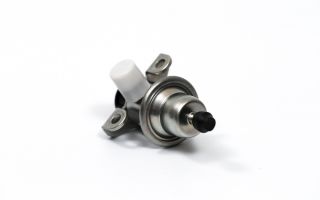Fuel pressure regulator: symptoms of malfunction, check, repair
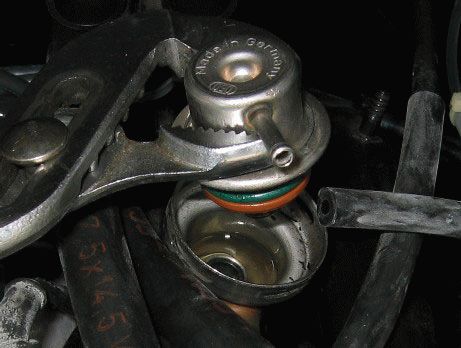

The fuel pressure regulator is a diaphragm valve. Fuel presses on it from one end, and the intake manifold spring presses on it from the other.
At lower speeds, the valve opens, accompanied by the draining of residual fuel from the engine into the tank. The next time fuel is supplied, the pump starts, drawing the liquid through the filter.
There is a special stabilizer on the fuel rail, whose task is to maintain optimal pressure in the system.
If this component breaks down, the engine power of the machine drops and uneven operation of the engine is felt. To protect yourself from this, you need to systematically check the regulator and promptly respond to symptoms of damage to the device.
Signs of a malfunctioning fuel pressure regulator
If your car's engine stalls at idle or engine power drops while driving, these may be symptoms of a faulty fuel pressure regulator. Most often, a sudden increase in fuel consumption is a signal of RTD failure.
There are other signs of breakdowns:
- the engine runs unevenly;
- at idle speed the engine stops;
- the crankshaft speed suddenly increases or decreases;
- The cooling system does not work well;
- the engine noticeably loses power;
- when you press the gas pedal there is partial or complete response;
- the engine seems to choke;
- poor acceleration of the car when changing gears;
- vehicles begin to move frequently in jerks;
- rapid fuel consumption occurs.
The presence of even one of these signs requires checking the condition of this device.
How to check the fuel pressure regulator?
There are several simple ways to determine the causes of problems and defective components:
- Visual method. A simple inspection without the use of any fancy tools is fine for carburetor engines. Pinch or disconnect the valve and observe the flow of fuel. The intensity of the fuel flow will help identify the malfunction. This method of verification is effective in its own way, but one cannot count on absolute accuracy.
- Method using a pressure gauge. Place a pressure gauge between the fuel hose and the fitting. To do this, temporarily disconnect the vacuum hose. The pressure level should change from 0.3 to 0.7 Bar. If the pressure indicator has not changed, repeat the operation with another hose.
- Hose clamping method. The pressure regulator is checked by pinching the return hose. A pressure gauge connected to the fuel system should give an immediate response. If the motor does not develop normal speed, you can determine the inoperability of the RTD without the device. Start the engine and clamp the return hose. Then track the RPM and listen to the engine. If the engine starts to run smoothly, then the problem lies in a faulty control valve that needs to be replaced.
How to repair an RTD?
As part of component repair, the following work must be performed:
- Look under the hood of the car where there is a fitting plug designed to control fuel pressure. Unscrew it, then using a special protective metal cap, carefully unscrew the spool inside the fitting.
- Connect the hose with the pressure gauge and secure it to the fitting using a clamp. After starting the engine, check that the pressure reading on the measuring device does not exceed 3.25 Bar.
- Disconnect the vacuum hose from the RTD. This operation should be accompanied by an increase in pressure. If nothing happens, repairing the fuel pressure regulator is useless; you will have to replace the element with a new one.
If the part cannot be repaired, we proceed to install a new device.
- Disconnect the vacuum hose. The pressure will begin to increase. Having reduced the pressure in the power system, proceed to remove the vacuum hose. You will need to unscrew the securing nut on the fuel drain pipe, where diesel or gasoline flows through the fuel filter to the RTD.
- After unscrewing the two bolts securing the device to the fuel rail, you can safely remove the regulator from the fuel discharge tube itself. The ring remaining in the ramp can be easily removed by hand and placed on the regulator before installation.
- Install a new regulator and perform all previous steps in reverse order. Make sure the new device is in working order, only then proceed with complete assembly. Upon completion of installation, perform a control check of the operation and serviceability of the device.
Conclusion
The fuel pressure regulator is a small but very important part of the vehicle fuel system. If you inspect the fuel pressure regulator often enough and change it on time, you can avoid a large number of problems.
Replacing the device with a new one is easy and inexpensive. Large financial losses will result from the repair of the fuel system, which may completely fail due to a non-functioning RTD.
Source: https://ddcar.ru/blog/remont/priznaki-neispravnosti-regulyatora-davleniya-topliva
Fuel pressure regulator: diagnostics, repair, replacement
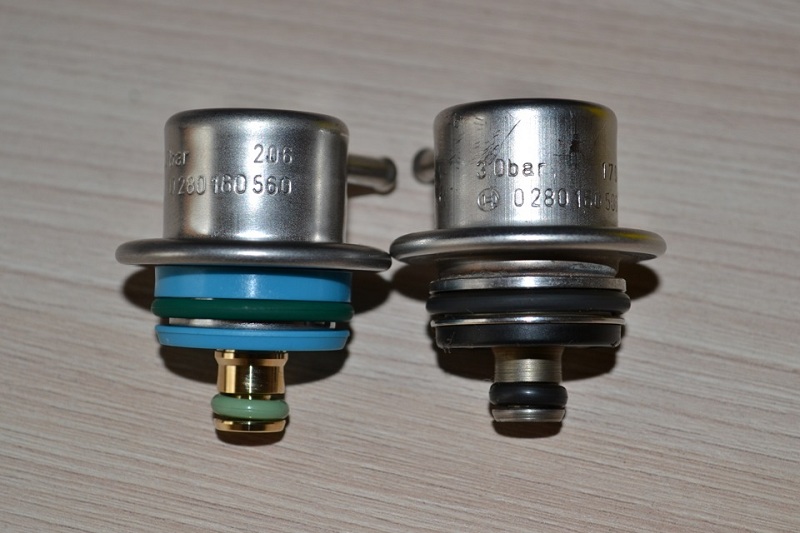
Modern cars are equipped with electronic fuel pumps; mechanical ones are found only in cars manufactured before 2000. The task of this component is to ensure an uninterrupted supply of fuel.
Everything functions well at high engine speeds, but problems arise when moving to low and idle speeds. Increased pressure damages fuel supply hoses and other system components. The fuel pressure regulator protects against such consequences.
If there are malfunctions in it, this can be determined by several signs.
Appearance of the fuel pressure regulator
The regulator (RTD) consists of a housing, a valve, a diaphragm and a spring, which are located on the fuel rail, in the fuel return hose of the power supply system, or directly in the tank (if the car does not have a recirculation system). The purpose of the product is to send excess fuel back to the tank. When the engine speed increases, the resulting vacuum opens the valve slightly, and the excess returns to the tank.
Location of the fuel pressure regulator in the fuel supply system
- the engine stalls at idle;
- engine power is greatly reduced;
- when accelerating, it is not possible to achieve normal dynamics;
- the car reacts poorly to pressing the gas pedal;
- fuel consumption suddenly increases greatly;
- the amount of carbon dioxide emissions increases;
- the crankshaft rotation speed changes.
All these problems arise due to the fact that the regulator becomes clogged or completely clogged over time. Another common cause of failure is weakening of the spring, leading to a strong decrease in pressure. In the absence of normal pressure, fuel supply decreases, power decreases and controllability deteriorates. Such problems are especially common on Ladas - Kalina and Priora, as well as on cars of the 2110, 2112, 2114, 2115 series.
To check the part, you need to carefully inspect it itself, the vacuum hose and all connections. Any leaks found must be corrected. It is also recommended to check the membrane. Disconnect the tube that goes from the RTD to the receiver and shake it. If no gasoline comes out from inside and there is no strong odor, then the membrane is in order.
RTD in diesel engines
Diesel vehicles running on the Common Rail system are also equipped with a pressure regulator. It fits into the fuel rail or is located on the high pressure fuel pump housing. The principle of operation is approximately the same. A special valve diverts unused fuel into the return line, preventing excessive loading.
In diesel engines, the regulator has a slightly different structure than in gasoline engines. It consists of a solenoid and a rod, which rests against a ball to shut off the return line. The design protects the engine from hydraulic vibrations and, as a result, from rapid wear.
To determine a breakdown, the following procedures are performed:
- The fitting plug is unscrewed - the element that controls the fuel pressure.
- The O-ring is inspected - if it is damaged, this component must be replaced.
- The spool is removed from the fitting.
- The engine starts, the pressure in the regulator is measured with a pressure gauge.
- The information received is compared with that specified by the manufacturer.
You can check the performance of the RTD yourself, even without tools. To do this, just pinch or disconnect the valve and study the intensity of the stream. A pressure gauge will give a more accurate result.
It should be connected between the fitting and the fuel hose, having first disconnected the vacuum hose. The measurement is taken at idle speed.
The information obtained depends on the car model - for example, in a VAZ 2110, the pressure indicator should start at 0.3 and gradually increase to 0.7 Bar.
Fuel pressure regulator with connected pressure gauge
Has your blood pressure changed? You may have connected the pressure gauge incorrectly. Check the connection. If everything is correct, it means the regulator has become unusable.
Where is the fuel pressure regulator located and how does it work (video)
What are the consequences of malfunctions in the operation of RDTs?
Over time, the engine starts more and more poorly. Fuel begins to come out of the cracks, which leads to a strong increase in its consumption. When the pressure changes unevenly, the dynamics of movement are disrupted, surges occur, and the car jerks during acceleration.
Is it possible to repair a failed part? In most cases, no, you have to completely change it. Repair units are almost always non-separable. Some experts suggest repairing the component, but this is dangerous. It is better to buy a new regulator - fortunately, it is inexpensive.
Determining violations in the operation of RTDs is not a very difficult task, which can be handled independently. Remember that this part of the machine needs to be checked periodically. By detecting the problem in time, you will protect important car components from rapid wear.
Source: http://autozam.ru/soveti/regulyator-davleniya-topliva-diagnostika-remont.html
Cleaning the MonoMotronic fuel pressure regulator
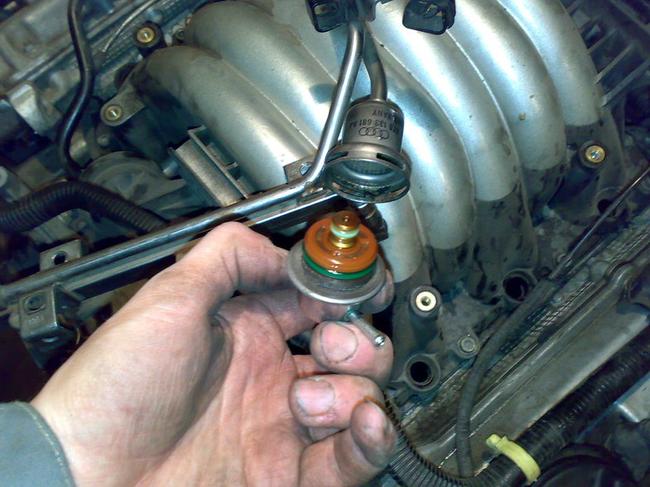
The information is applicable for the repair of cars with a Mono motronic injection system (ABS, AAM, ABD, ABU engines, etc.)
These engines were installed on cars:
Volkswagen Passat B4 / Volkswagen Passat B4 (3A2) 1994 – 1997 Volkswagen Passat Variant B4 / Volkswagen Passat Variant B4 (3A5) 1994 – 1997
Volkswagen Passat B3 / Volkswagen Passat B3 (312) 1988 – 1994
Volkswagen Passat Variant B3 / Volkswagen Passat Variant B3 (315) 1988 – 1994
Volkswagen Golf 3 / Volkswagen Golf 3 (1H1, 1H5) 1992 – 1998
Volkswagen Vento / Volkswagen Vento (1H2) 1992 – 1998 Volkswagen Golf Cabriolet 3 / Volkswagen Golf Cabriolet 3 (1E7) 1993 – 2002
SEAT Ibiza 2 / Seat Ibiza 2 (6K1) 1993 – 2002
SEAT Cordoba Mk1 / Seat Cordoba (6K2) 1993 – 2002
SEAT Toledo / Seat Toledo (1L) 1991 – 1999
and etc.
For cleaning we will need: Socket 10 Pliers Torx keys 20 and 25 Clean rag or napkins
A little gasoline, water and maybe a little carb cleaner.
0. Open the hood, we see something like this
1. Disconnect all vacuum pipes from the scroll: two for the cold/high valve on the back side and one for ventilation of crankcase gases from below. We unscrew the three bolts with a 10mm head, lift the snail and move it to the side. The corrugation does not need to be disconnected from it.
We get something like this.
2. Just in case, disconnect all connectors.
We bleed off the pressure in the fuel system - use pliers to move the clamp on the supply pipe, place a rag or napkins under the junction of the pipe book with the mono-injection body and carefully remove it, slightly turning the pipe back and forth. Gasoline will flow from it. After standing for about 15 minutes, very little spilled out - three napkins successfully absorbed everything.
3. Carefully pull out the 4 wires from the plastic holder, use a Torx-25 wrench to unscrew the bolt securing the injector cap (on which the DTVV lives), carefully lift it up and put it aside.
4. Remove the black plastic ring from the fuel pressure regulator (it was in it that the wires from the DTVV were held), hooking it on the right edge.
Again, carefully use a Torx-20 wrench to unscrew the 4 bolts securing the pressure regulator cap diagonally. Be careful - the spring may pop out. It didn’t pop out for me, because everything inside was sour and stuck.
5. Remove the lid and set it aside.
Gently and without sudden movements remove the metal cover. It may be dried up, but you should not pull it sharply - both it and the spring from under it may fly away. We lift the lid...
And we see a spring on the membrane
6. Having removed the lid and spring, Her Majesty the Membrane appears to our eyes
7. Use your hand (not a screwdriver or knife!) to pull it out. If he doesn’t want to go, carefully turn it a little and move it, but remove it. We don’t touch it with anything sharp. Having removed the membrane, we see:
8. Using a slightly damp (water or gasoline) napkin or cloth, clean everything – the body, the membrane. Do not Carb Cleaner on the membrane - it will corrode it.
You can use a carb cleaner to wash the spring and regulator cap. But be sure to wipe it dry with a clean cloth or napkin! so that the membrane does not come into contact with the carb cleaner.
9. When everything is dry and clean, reassemble in the reverse order: Put the membrane in place. On the reverse side there is a slightly movable “pipstick”. We put it in a level position and simply lower the membrane into its seat. Place a spring in the top center and place the cap on top.
We put the outer fastener on the lid with the curved center down and carefully evenly press the fastener to the body.
First we attach 4 bolts diagonally, then fasten them with a Torx-20 key. Tighten not to the point of awesomeness, but with the same force with which they were screwed earlier. We put a plastic ring on top.
We thread the wires from the injector cap into the wire holder on the ring, carefully put it in place and fasten it with a bolt - Torx+25 key. We put on the fuel supply hose, fix it with a clamp. We put on the mono-injection volute, screw in three bolts with a 10-head head, connect all the vacuum pipes to the volute ( three pieces) Connect all disconnected connectors.
Let's start.
Result:
After cleaning, my idle became more stable, stopped floating, the engine started up a little differently - more softly, or something.
Addition from scorpi:
Suddenly a problem appeared: I started starting it in the morning (the car is parked outside, in any frost it started without problems, at -40 as at +20), the pump buzzes as if the tank is dry (the tank has 30 liters). I don’t even grab the starter when I turn it.
I decided to check the fuel supply, the pump was changed before the New Year, I couldn’t unscrew the fuel supply hose from the Monica, so I went to the pump. I removed the supply hose from the tank and there is no pressure in the hose. I turned on the ignition from the pump, fuel sprayed out well, put the ignition hose back on, at first the pump hummed as expected, quietly, then noisily again.
I used a screwdriver to pry off the supply hose on the tank and the fuel sprayed out well (pressure built up in the hose). Conclusion: there is pressure up to Monica. The pressure sensor remains. I'm taking off the air turtle and there isn't much ice. I warm the sensor with an industrial hair dryer for 30 seconds.
, it starts without problems and so on every morning for a week!!! I just warmed it up in the morning without removing the turtle, the place where the hoses fit. Today, after reading everything here, I went to disassemble the sensor.
I took off the turtle. We see ice.
and there's ice
washed it a little
what needed to be proven - water
clean under the membrane
Washed it, assembled it, started it. It started up, as they wrote above, really differently, before when it was cold it took longer to turn it on. I think the problem is solved!
Continuation and all discussions of the report here
Thanks: d.lus
Decoding of the factory equipment of the car (English)
Decoding of the factory equipment of VAG
Diagnostics of Volkswagen, Audi, Skoda, Seat, error codes.
If you have not found information on your car, look at the cars built on the platform of your car.
Most likely, the information on repair and maintenance will be suitable for your car.
All documentation in English is marked , in German – For all who have Volkswagen, hands and desire to do something with them... For all who have Volkswagen, hands and desire to do something by them...
Volkswagen Technical Site ©1999-2018 by Nick Pitchik | Contacts, advertising on the site / Contact Us
Source: http://vwts.ru/articles/injector/chistka-regulyatora-davleniya-topliva-monomotronic.html
Signs of a malfunctioning fuel pressure regulator
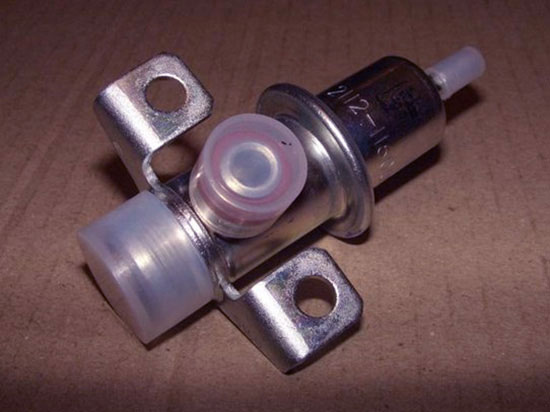
Signs of a malfunctioning fuel pressure regulator
Every engine fuel system contains a fuel pump. Electric fuel pumps have recently been installed in gasoline engines; mechanical models are already outdated and are no longer used on modern vehicles. Mechanical fuel pumps live out their days on cars produced in the last century.
The performance of the electric fuel pump must be such as to ensure uninterrupted fuel supply at any engine speed and under any load.
But what to do when the engine is running at idle or low speed, and a small portion of fuel is required? After all, the pressure that is created in the engine power system for heavy loads will be excessive at idle speed.
And excess pressure can lead to disastrous results - breakage of fuel hoses or other damage. For normal operation of the fuel system, there is a fuel pressure regulator.
What is a fuel pressure regulator?
The fuel pressure regulator (FPR) is a vacuum valve; it transfers excess fuel through a return hose into the fuel tank. The RTD is a housing that contains a valve, a membrane and a spring.
There are also three terminals in the housing: two terminals for the passage of fuel through the regulator, the third is connected to the intake manifold. As engine speed increases, the vacuum created in the manifold (at the third terminal) overcomes the force of the spring and moves the membrane, thereby opening the valve slightly.
Excess fuel gets access to the second outlet and goes back to the gas tank. An RTD is often also called a check valve.
As a rule, the check valve is located on the fuel rail; it can also be embedded in the fuel return hose of the power supply system.
Causes of fuel pressure regulator malfunctions
RDT may fail for several reasons. For example, defective parts are found on Russian-made cars. There are significantly fewer defects on foreign models, but you can purchase a defective RTD by purchasing a non-original spare part.
Mostly the check valve breaks down due to natural aging. Let's say this can happen after a hundred thousand mileage or more. It should be noted that check valve failures are not common. Most often, in an RTD, the membrane dries out over time, less often the valve jams, and even less often the spring breaks or weakens.
Sensor failure may occur due to low-quality gasoline. For example, in winter, fuel was filled with water, and water got into the regulator.
If the fuel filter is not replaced on time, dirt gets into the parts of the power system, including the regulator. In this case, the RTD valve most often jams.
It’s hard to imagine what could happen to the spring, but apparently, it still breaks sometimes.
Characteristic symptoms of fuel pressure regulator malfunctions
By what signs can you determine that an RDT is not working:
- the engine is very difficult to start, you need to turn the starter for a long time and at the same time keep the gas pedal pressed in order for the engine to start;
- The engine idles unsteadily or the speed is very low, the engine often stalls. At the same time, it does not gain power at all; when trying to accelerate, it results in a deep failure;
- The spam engine changes speed sharply, this is especially noticeable at idle:
- Fuel is leaking from the fuel hoses. Attempts to tighten and replace clamps and replace hoses do not help.
How to check the fuel pressure regulator for serviceability
The fuel pressure regulator is not an electrical sensor and cannot be checked using instruments. It should also be taken into account that the RDT cannot be disassembled or repaired.
Someone writes that the fuel check valve can be repaired. I would like to see what it looks like and where you can buy a repair kit.
Typically, RTDs are inexpensive, and even for that reason they would not be worth repairing if they were repairable.
You can verify that the regulator is working properly by checking the pressure in the fuel system. This is usually done with a mechanical pressure gauge, which is connected to the engine power system.
Measurement is carried out as follows:
- connect the pressure gauge to the fuel system;
- start the engine and look at the pressure gauge readings.
The standard system pressure for a passenger car is usually within 3 kg/cm2. When stopping the engine, the pressure should not drop immediately - the regulator closes the return flow. If the pressure gauge needle quickly goes to zero, the RTD is most likely faulty.
Another way to check: if you manage to pinch the fuel return hose while the engine is running, then if the regulator is working properly, the pressure in the fuel system should increase. The indication of the arrow of the device depends on the degree of compression. But there are foreign cars where it is impossible to clamp the return line - instead of rubber hoses there are metal tubes, or the hoses are very short.
In some cases, by squeezing the return hose, you can verify that the RTD is faulty without a pressure gauge. But this is only due to one sign - when the engine idles and does not develop speed at all. If, when the return line is compressed, all cylinders begin to work and the engine acquires the required power, then the RTD is definitely faulty and needs to be replaced.
Latest articles
http://avto-kuplya.ru
Source: http://legkoe-delo.ru/remont-avtomobilya/automobile/93611-priznaki-neispravnosti-regulyatora-davleniya-topliva
=58A
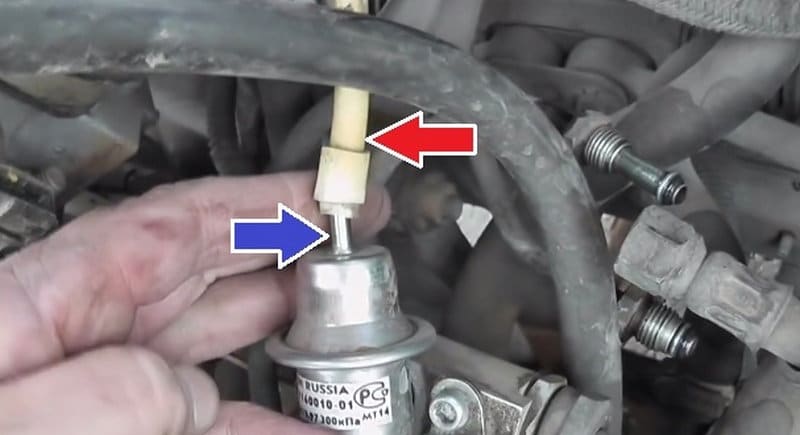
Added 2 years ago. Channel: Alexey Sa...
Shure beta 58a is a fake, how to distinguish it from...
There are many high-quality fakes, but there is still a way to distinguish...
Added 2 years ago. Channel: PeriscopeF…
BELL TEXTRON OH-58A KIOWA US ARMY FAMI…
Created by the US Army in 1967, this film about the Bell OH-58 Kiowa helicopter features footage from the Vietnam War, emphasizing the concept of ai…
9 months added. back. Channel: Andrey Siv...
assembly of the BRAIT BR-58A walk-behind tractor
subscribe and don’t miss new and interesting videos))) link to new product: in Ukraine: https://hozain.in.ua/g637643-motobloki-motokult…
Added 1 year ago. Channel: Marcos Oli...
Shure beta 58a original
como identificar seu verdadeiro shure beta 58a.
Added 12 months. back. Channel: Khang Pham
Shure beta 58a hang chuân mexico
Added 2 years ago. Channel: MICROFON
Review, comparison of the Shure beta 58 microphone...
Review, comparison of Shure beta 58A microphone, (COPY AND ORIGINAL) You can buy here http://microfon.in.ua/search/?search=Shure%20beta%2058a.
Added 4 months. back. Channel: Foreman Wholesale
Assembling the Daman 58A walk-behind tractor
https://vk.com/prorab_chelny http://prorab-opt.ru/products/motoblok-daman-dm-58a t. 89503187566.
Added 3 years ago. Channel: André Melo
teste Shure beta 58a Chinês, Made in Chi…
André Melo – testando o microfone Shure Beta 58a – Made in China – Xing Ling Dindi – Tom Jobim Microfone plugado direto em uma placa Presonus AudioBox…
Added 12 months. back. Channel: TrainedZom…
Fake Shure Beta 58A from Wish.com Review
I ordered a cheap microphone from wish, the same one shown on Geek. It did not advertise the Shure logo, but the actual product had it. This is my unb…
Added 12 months. back. Channel: Soundterr
Microphone UKC beta 58a. Even better and cheaper...
Product link: http://soundterr.in.ua/index.php?route=product/product&product_id=843 Large selection of radio and wired microphones. Cash...
Added 2 years ago. Channel: Shure India…
Shure Vocal Microphone comparison Beta 5…
Which one of these dynamic vocal microphones is the best one for you? This video explains the differences in Hindi. Please connect to us at…
Added 2 years ago. Channel: Shir Soul…
Shure SM58, Shure Beta 58a, EV NC 767a, …
Welcome to Shir Soul Sound! For bookings and info, contact: David Ross – 917-817-2897 ~ [email protected] Microphones featured in this video: …..
Added 1 year ago. Channel: Soundterr
Shure beta 58a copy
Review of a copy of a wired microphone Shure beta 58a soundterr.in.ua – store of sound, light, effects. Link to product page...
Added 1 year ago. Channel: TechNocion
Shure GLXD24 beta 58a wireless microphone…
Shure GLXD24 /B58 Digital Vocal Wireless System With BETA 58A Handheld Microphone Shure wireless: http://amzn.to/2qP7szl.
Added 1 year ago. Channel: Crazy Sahn…
Unboxing BETA 58A Mic review under 500 R…
hello Friends, Today I purchased Mic BETA 58A, in this video I unbox and test this Mic. This is best mic under 500 If you want buy this mic. Click On...
Added 3 years ago. Channel: MicRentals…
Shure BETA 58A Review
Today we are talking about the SHURE BETA 58A. To test out and rent this microphone: micrentals.com/shure/shure-beta-58a/ Thank you for watching! Her...
Added 3 years ago. Channel: Musician's…
Shure Beta 58A Mic
For more information: http://www.musiciansfriend.com/dynamic-microphones/shure-beta-58a-mic As a singer or a rapper, your voice is your instrument and…
Added 2 years ago. Channel: Richard Sa...
The Mark 58A
Great day for a run back in 2012.
Added 5 years ago. Channel: Railson Na…
bang bang 58a
Source: http://www.fassen.net/show/%D0%BD%D0%B5%D0%B8%D1%81%D0%BF%D1%80%D0%B0%D0%B2%D0%BD %D0%BE%D1%81%D1%82%D1%8C+%D0%A0%D0%95%D0%93%D0%A3%D0%9B%D0%AF%D0%A2%D0%9E%D0 %A0%D0%90+%D0%94%D0%90%D0%92%D0%9B%D0%95%D0%9D%D0%98%D0%AF+%D0%A2%D0%9D%D0% 92%D0%94+COMMON+RAIL
Avtokar
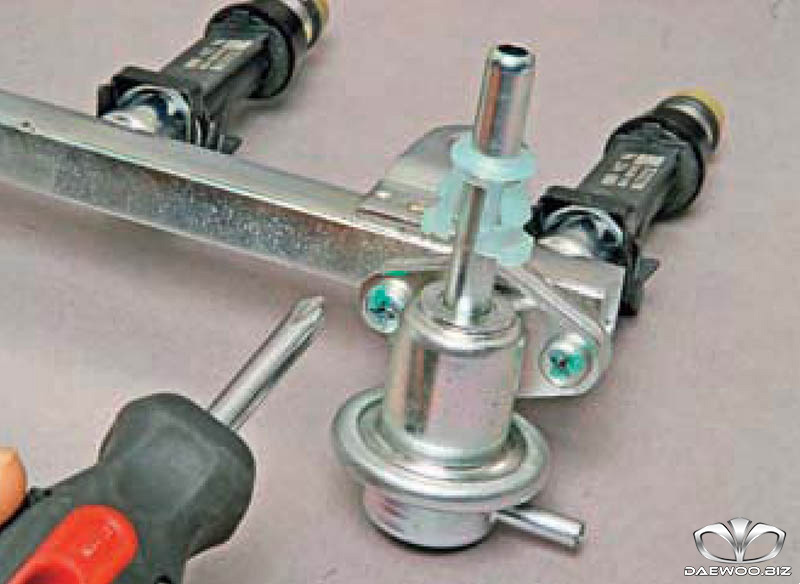
October 4th, 2014 Posted by Autonews, News
The fuel pressure regulator is one of the many components of a car that, as a whole, create what we know as a car. The very name of this unit implies its main purpose - regulating fuel pressure. From this we can also conclude that this unit belongs to the car’s fuel system.
To immediately clarify the question of why adjust the pressure in the fuel line at all, I note that modern cars are quite complex technical mechanisms, which designers struggle to improve from year to year.
So, taking into account every nuance in the operation of a car and its engine is possible only by obtaining data on the state of one or another of their parameters and responding to it in a timely manner. The same applies to .
And the fuel pressure regulator is precisely designed to help control (or create) constant pressure in the fuel system.
Description and principle of operation of the fuel pressure regulator
What is a fuel pressure regulator?
Chevrolet Niva fuel pressure regulator.
- frame
- lid
- vacuum hose fitting
- diaphragm
- valve
- A – fuel cavity
- B – vacuum cavity
A fuel pressure regulator is a mechanism where most pressure adjustment occurs by opening a spring-loaded diaphragm, which releases the excess pressure back into the fuel tank.
In addition to the spring, the force required to open the membrane is controlled by the engine itself, depending on the operating mode in which it is directly located.
Most often, such control is carried out through rarefied air (“vacuum”) by connecting the inlet manifold with a flexible hose and the sealed cavity of the pressure regulator, one of the walls where the very membrane is located.
The principle of operation here is simple: if the engine needs less fuel pressure, this happens when the throttle valve () is closed, the vacuum forces in the intake increase, thereby creating a force opposite to the direction of pressure of the regulator spring. Meanwhile, the force generated by the fuel pump remains unchanged, the membrane opens slightly, and the fuel is directed back into the tank.
By the way, in addition to fuel pressure regulators based on the principle described above, there are also units where, instead of vacuum forces, an electric drive is used, controlled by the microprocessor brain of the car.
Where is the fuel pressure regulator located?
VAZ 2111:
Chevrolet Niva:
Fuel pressure regulator malfunctions
The most common malfunctions that can lead to failure of the fuel pressure regulator can be: mechanical damage to the parts of this unit or its clogging.
Mechanical damage and malfunctions are a consequence of the obsolescence of the materials from which the mechanism is made, as a result of which the pressure regulator begins to operate not in accordance with standard indicators. For example, a violation of the vacuum in a sealed cavity makes it impossible for the engine speed controller to control, and a weakened internal spring leads to reduced pressure in the fuel line.
The results that result from a clogged fuel pressure regulator are similar to those caused by mechanical damage, but unlike the latter, to restore the functionality of this unit, it is enough to simply rinse (clean) it.
How to check the fuel pressure regulator?
In order to identify malfunctions of the fuel pressure regulator, the vehicle is tested in accordance with the recommendations of the car manufacturer. Most often they involve checking the fuel system pressure at different engine speeds and comparing them with reference values.
In the future, the search for the reasons for the inoperability of the fuel pressure regulator is carried out by inspecting the tightness of the connections, the condition of the vacuum hose, as well as the regulator itself.
If a superficial inspection does not reveal any defects, the regulator is dismantled and, if possible, disassembled. If there is a suspicion of clogging of this unit, it is washed and retested.
Repair and replacement of fuel pressure regulator
If the true causes of a malfunction in the fuel pressure regulator are identified, the unit must be repaired using repair kits or the unit must be completely replaced.
The second outcome, in the event of a breakdown of the pressure regulator itself, is the most likely, since every year manufacturers are only enlarging repair units. And the units are non-separable and, according to manufacturers, must be replaced during assembly. Therefore, you are unlikely to find original spare parts for such units.
At best, the repair technology will be described by some “Kulibin” using unlicensed, most often Asian, spare parts.
In conclusion, I would like to make sure that your technical vocabulary has been replenished with new necessary information that will be useful both for your own development and for applying it in real life.
It’s no secret, but previously a real driver knew everything about the car’s operation thoroughly and could independently repair it. Today, we have turned from drivers into a gray mass of unknowing motorists.
So strive to join those great origins of the automobile era!
Fuel pressure regulator video
Source: http://avtokars.ru/novosti/regulyator-davleniya-topliva-opisanie-princip-raboty-neispravnosti-remont-i-zamena..html
Malfunctions of the fuel pressure regulator, signs of a malfunction, how to replace the fuel pressure regulator. Fuel pressure regulator: diagnostics, malfunctions, replacement, useful tips. How to replace the fuel pressure regulator with your own hands: materials, tools, pro tips
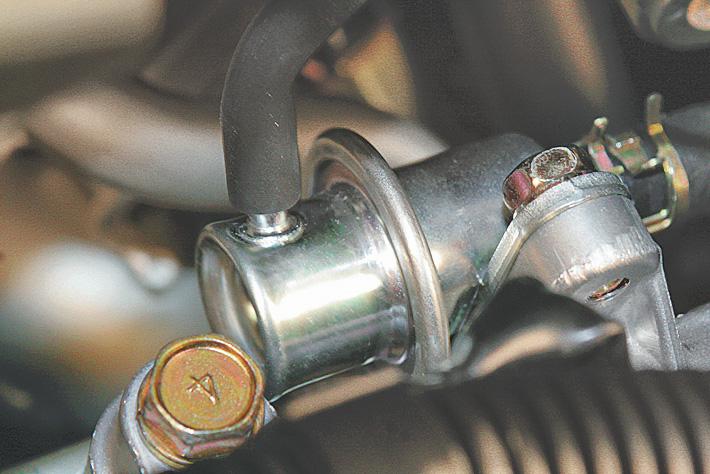
The FPR (fuel pressure regulator) is popularly called a “check valve” or “bypass valve”.
Most often, when the following problems occur with the engine: loss of power, unstable idling, poor starting, jerking, they do not pay attention to the fuel pressure regulator.
And it’s completely in vain, since the RTD plays an important role to ensure normal engine operation.
Fuel pressure regulator, why is it needed for a car with an RTD installed?
The amount of fuel that enters the combustion chamber directly depends on the operating time of the injector, as well as on the pressure in the fuel rail and the pressure in the intake manifold.
To control these three factors and to more accurately calculate the amount of fuel in fuel recirculating systems, a fuel pressure regulator is installed.
The design of the RTD is such that it can maintain a pressure difference: the fuel pressure in the injector, and, at the same time, the air pressure inside the intake manifold. In this case, excess fuel is returned back through the line to the fuel tank.
To maintain differences across all injectors, the fuel pressure regulator is mounted at the very end of the fuel rail.
In systems where fuel recirculation is not provided, the RTD is mounted directly in the fuel tank.
Due to its design features, the regulator can maintain fuel pressure at atmospheric pressure.
Therefore, the difference between the fuel pressure and the pressure inside the intake valve is not constant. For this reason, the difference must be taken into account when the duration of injection of the fuel mixture.
RTD device
The fuel pressure regulator is a simple unit; its detailed structure is shown in the figure:
The valve holder is attached to the membrane and presses the valve to the seat. Fuel, which is fed into the chamber under pressure through the inlet passages, exerts pressure on the membrane from below.
A spring in the intake manifold presses on top of the membrane. Sometimes fuel pressure can exceed spring pressure. In this case, the valve opens, through which fuel enters the return line.
Therefore, the pressure inside the intake manifold must be taken into account.
During operation of the fuel pump, fuel flows from the fuel tank to the filter, where it is cleaned, and then supplied to the pressure regulator. The RTD, in turn, constantly maintains the required fuel pressure in the system. In this case, all processes must proceed synchronously.
The entire regulator system is housed in a steel housing that can withstand high pressure. The mechanism is equipped with a diaphragm and a check valve, which prevents pressurized fuel from returning to the return line.
How does the fuel regulator work? RTD operating mode
The main operating mode of the RTD is idle. It is at this moment that the vacuum of the fuel mixture reaches its lowest point, and the pressure in the fuel rail reaches its highest. It must be taken into account that the pressure in the ramp directly depends on the degree of vacuum of the fuel mixture inside the suction manifold: the lower the vacuum, the higher the pressure.
During idling, pressure and vacuum indicators reach maximum values. The maximum pressure value is applied to the RTD body to monitor the pressure during diagnostics of the fuel supply system.
An important point: in most cases of failure of the RTD, there is no point in repairing it; it just needs to be replaced with a new one.
To prevent malfunctions, the regulator must be regularly checked and the pressure in the fuel system monitored. Regular preventative checks will help avoid breakdowns and save money on the purchase of spare parts.
In addition: regardless of the engine operating mode, the RTD must clearly respond to all changes in operation.
If the RTD is faulty, how does it affect the engine?
If a car is operated for a long time without regular inspection and minor repairs, this will inevitably lead to malfunctions of one or more systems. If we talk specifically about the fuel pressure regulator, then most often, after some time, its spring gradually sags and does not create the required force, as a result of which the fuel returns to the tank through the return line.
This process significantly reduces the pressure in the fuel rail, which leads to a noticeable loss of engine power. Unfortunately, this is only one of the problems that arise with a faulty RTD.
So, the engine, losing power, begins to stall at idle, and when changing gears the car picks up speed very poorly. Jerks may occur during movement.
In this case, the engine begins to choke and does not respond to the gas pedal, increased fuel consumption occurs, etc. We will consider all the “symptoms” of a faulty fuel pressure regulator in detail below.
RTD is faulty, signs of malfunction, how the malfunction affects operation
Some problems can be determined directly by ear, but not all. Other breakdowns appear directly when the car engine is running.
Of course, such changes do not affect the performance of the car for the better. Therefore, as soon as at least one of the symptoms listed below is noticed, it is necessary to take immediate action.
First of all, you need to check the condition of the RTD if the following “symptoms” appear:
- The engine starts to run very unstable. Moreover, the engine does not “trouble” (as happens with faulty or dirty spark plugs). The sound of the engine becomes uneven, reminiscent of the rumble of a train on the rails.
- At low idle speed the engine begins to stall. Of course, this feature is typical for many problems: incorrect installation of the drive belt, dirty or flooded spark plugs, dirty carburetor, etc. So if only this “symptom” is present, many nodes will have to be checked.
- During operation, the engine begins to run jerkily, “sinking” begins, and fuel consumption increases sharply. However, again, all these signs indicate problems in different nodes, so it is highly advisable to draw final conclusions based on the totality of the signs.
- There is a strong increase in carbon monoxide in the exhaust gases (you can check it either with a special device or “by smell”).
- When shifting to a higher gear, the car accelerates slowly and slowly.
Reasons for RTD failure
Actually, there are only two main reasons:
- Valve failure.
- The valve doesn't hold.
If the RTD valve breaks down, excess gasoline does not flow back into the tank, resulting in an increase in pressure of 2.5 kg/cm2 and higher. This malfunction inevitably affects the amount of fuel that enters the combustion chamber - that is, consumption increases greatly, while not all of the fuel burns and is wasted.
When the valve does not hold, gasoline, as they say, begins to “stagger” through the system. This reduces the fuel pressure, hence the occurrence of “dips” with a sharp increase in car engine speed. The power and throttle response of the engine decreases significantly; when starting, the load on the battery increases - you have to turn the starter for a long time to create the required fuel pressure.
How to check an RTD with your own hands. Pro tip
There are several ways you can use to check the condition of the RTD in your garage. The “classic” option, also known as the oldest option, is to disconnect or clamp the bypass valve, while observing the force of the jet pressure. This method was popular when checking pressure on VAZs. Currently it is practically not used.
Today, the simplest and most reliable way to check is to use a pressure gauge.
It is necessary to set the engine to idle speed, then connect a pressure gauge between the fuel hose and the fitting, having first disconnected the vacuum hose.
When taking measurements, the pressure in the fuel system should not rise above 0.7 Bar.
How to replace an RTD with your own hands. Tools, devices, equipment and consumables
You don't need many tools to replace the fuel pressure regulator. You will need the following:
- Hex keys of the required size (most often “5”).
- Wrench "25". Screwdriver.
- Actually, the regulator itself.
Having prepared this simple set, you can begin replacing the RTD. The procedure is as follows:
We unscrew the fitting plug, there is a corkscrew ring inside. We examine it carefully. If there is damage - the ring is torn, cracked, stretched, etc., then the entire plug must be replaced.
Next, unscrew the spool from the fitting. The spool is exactly the same as on the wheels of the car, so it is not difficult to identify it.
Remove the vacuum pump from the check valve.
Unscrew the nut that secures the fuel drain pipe.
We unscrew the hexagons that secure the RTD to the ramp.
We remove the check valve fitting from the ramp holes and disconnect the RTD itself from the drain tube.
After all the manipulations done, all that remains is to install a new regulator. In this case, all work is carried out in reverse order. During the process of dismantling and installing the RTD, no problems most often arise, except that the sealing ring can sometimes get stuck in the ramp, and it has to be pulled out from there.
If the ring turns out to be intact, it can be installed on a new check valve; if not, replace it.
How to find and order the right spare part for your car on Aliexpress at a reasonable price and free delivery
Recently, the Aliexpress portal has become very popular. This is not surprising - you can buy whatever your heart desires there, and at very reasonable prices.
Those who ordered goods from China 5-6 years ago undoubtedly remember the long delivery times (up to six months), problems at customs, and other troubles.
Now delivery times to the CIS countries have been reduced to two to three weeks, there are more ways to pay for goods, the website has become simpler and more convenient for the buyer.
A huge number of car enthusiasts order parts for their cars on Aliexpress. You can buy everything. Fuel pressure regulators are no exception - for any brand. To make a purchase, you must complete the following steps:
Register in the system. To do this, enter your data (in Latin!) in the appropriate fields:
After registration, go to your profile and enter the address to which the purchased product will be delivered to you (also in Latin).
Next, we begin to search for the desired object. In the search bar, type the desired product name and tick the “free shipping” checkbox:
After selecting the appropriate product, click the “buy now” button and pay using any available method presented on the website:
- Tuning VAZ 2114: modification of the VAZ 2114, a little about everything
- Throttle body, DIY throttle body cleaning
- Lada Vesta official versions. Advantages and disadvantages of Lada Vesta
- How to repair the gear motor of a VAZ 2110 stove
- Kalina stove control unit: design, repair and replacement of the Kalina stove control unit
- What is a pneumotester, how to evaluate its readings?
- Oil pump VAZ 2107, do-it-yourself oil pump repair and replacement
- What to do if your car is stuck in the snow, useful tips
- The headlight is sweating from the inside, what should I do?
- The VAZ 2107 stove does not heat well: how to repair the stove on a VAZ 2107
- Anti-freeze, what is it and how to choose it correctly
- Car lamps: LED, halogen, ice lamps How to choose lamps in a car
- Reasons for antifreeze leakage: faulty cooling system, cooling radiator, heater radiator, faulty connections, antifreeze in the engine oil.
- How to replace a light bulb in a car
- How to photograph a car for sale, useful tips
- How to choose a car service (and save money at the same time), useful tips
- How to start a car in winter, useful tips
- What can knock in a car? How to determine the cause of a knock?
- How to diagnose a car yourself
- Autonomous preheater, autonomous preheater with remote or programmable start
- Replacing the silent block of the front suspension arm, how to replace the silent blocks of the front suspension with your own hands?
- Idle speed sensor malfunction VAZ Signs of a malfunction of the idle speed sensor VAZ 2110, 2107, 2109. Replacing the idle speed sensor with your own hands
- Is it necessary to warm up the engine?
- How to clean the throttle valve yourself?
- VAZ injector does not start well in cold weather, what should I do?
- How to replace a VAZ clutch fork?
- Replacing a 2110 clutch disc. How to replace a 2110 clutch disc without removing the transmission?
- How to replace VAZ tie rod ends with your own hands?
- Generator 2115 DIY replacement and repair
- Replacing generator bearings 2110
- Automotive clutch: device, operating principle, classification, types, advantages and disadvantages
- How to check generator 2110? How to remove generator 2110? DIY VAZ 2110 generator repair
- Why the rear window of the car does not heat up, do-it-yourself rear window defroster repair
- I flooded the candles in the cold, why the candles flood in the cold, reasons and how to fix them
- Car key with a chip, how and where to make a chip key for a car?
- How to stud winter tires correctly, stud winter tires with your own hands, useful tips
- Why do cars catch fire?
- Car electrical wiring repair. How to ring and determine the faulty wiring in a car?
- Replacing the camshaft sensor, how to do it in a car with your own hands
- How to close the starter directly
Source: http://prosedan.ru/neispravnosti-regulyatora-davleniya-topliva-priznaki-neispravnosti-kak-zamenit-rdt


